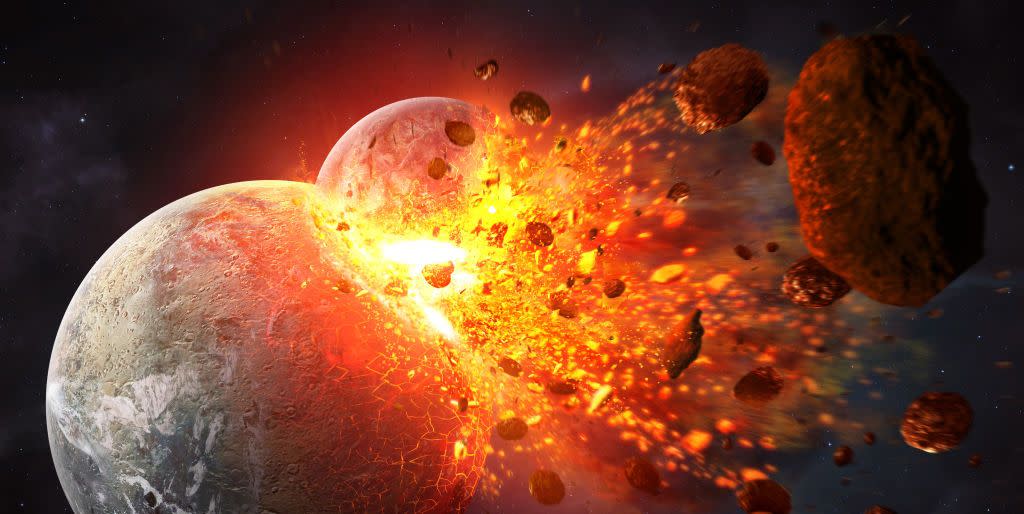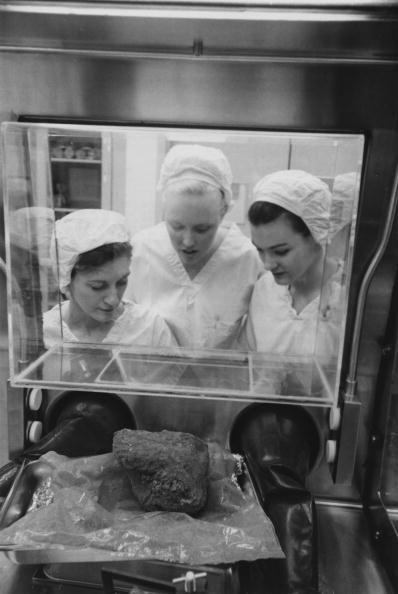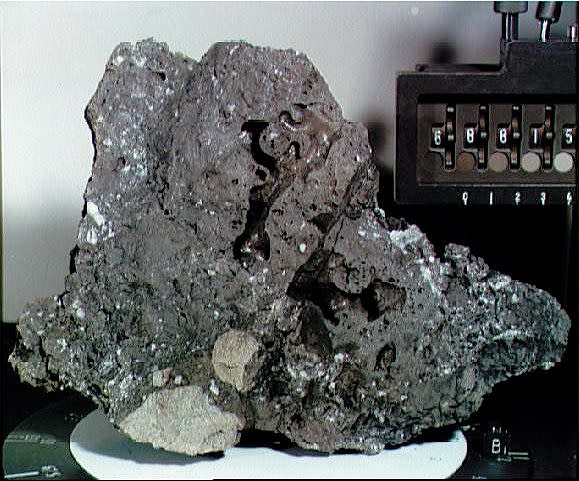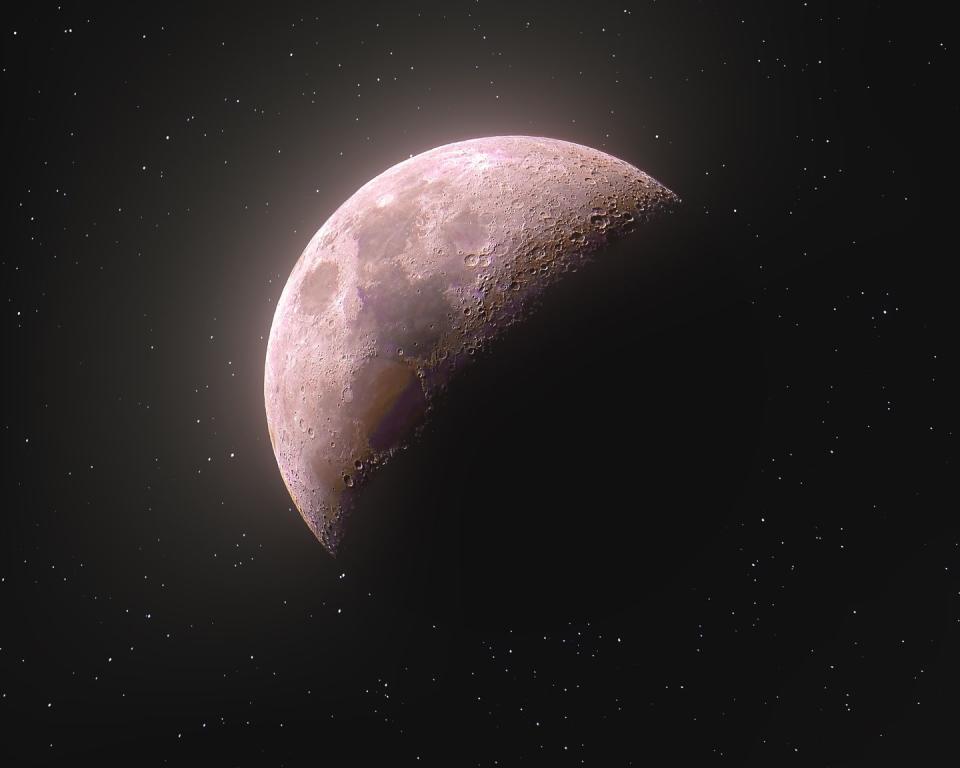How Did the Moon Form?

"Hearst Magazines and Yahoo may earn commission or revenue on some items through the links below."
A widely accepted explanation for how the moon formed is the Giant Impact Hypothesis.
Lunar research began in earnest when Apollo astronauts brought moon rocks back to Earth in 1969.
We are learning more about the moon than ever, as techniques for analyzing the chemical composition of old and new lunar samples continue to advance.
As one of Earth’s most familiar sights in the sky, the moon has inspired billions of people to gaze upward in wonder. Early in humanity’s history, we constructed myths about this silvery orb, and later, we pursued a space race to explore it on foot. Always, there was a standout mystery: how did the moon form and find a home orbiting our blue planet?
🌒 You love the cosmos. So do we. Let’s nerd out over it together.
Apollo astronauts kick-started scientific research to answer this question when they returned from the moon in 1969 with about 48 pounds of lunar rock and dust. By measuring the age of the rocks, scientists learned that the moon formed about 4.5 billion years ago, amidst the chaotic early years of our Solar System’s own formation. Today’s tools and techniques can analyze the chemistry of lunar material in ways that were impossible just 50 years ago, revealing more detail than ever before about the story of our moon.
☄️ The Giant Impact Hypothesis Remains the Best Explanation
The generally accepted model of the moon’s creation assumes that a massive object, dubbed Theia, crashed directly into Earth 4.51 billion years ago, when our planet was still busy growing to its current size and forming its core. The resulting impact vaporized part of young Earth’s mantle, tossing rocks and gasses outward. After some time, the ejected matter (a combination of Earth material and Theia material) began orbiting our planet. The clumps of gas, dust, and rock collided and stuck together.
After just a few thousand years—recent models reveal this surprisingly short period—they coalesced into a spherical shape that continued orbiting Earth. The early moon rock was so hot that it was an entirely molten world, and it took 150 to 200 million years to cool and crystallize into its familiar, gray, rocky exterior. Theia was the catalyst for our planet’s formation, too, as it helped push heavier elements like nickel and iron toward the core.

“Over the last 50 years, the Giant Impact Hypothesis has become the favored explanation, which I believe is the best approximation of what likely happened given the geochemical data we’ve been able to collect,” geochemist Erick Cano of the University of New Mexico in Albuquerque tells Popular Mechanics in an email.
While the Giant Impact Hypothesis is generally accepted, we still have many mysteries about the moon’s history.
The biggest challenge to planetary scientists trying to reconstruct the story of the moon is that their clues come from “very processed” rocks, Anthony Gargano, another geochemist at the University of New Mexico, tells Popular Mechanics. The moon has undergone billions of years of changes since its inception. Our satellite experienced vaporization, magma, and crystallization, all of which transformed the rocks.
🌝 Studying the Moon’s Chemical Composition for Clues

Luckily, measurement technologies used to study planet formation are rapidly improving. Scientists are able to measure chemical compositions in ways they were not able to in the Apollo days. For example, we can now examine a slice of moon rock under an electron microscope or even study a grain of moon dust using atom probe tomography (APT). This technique distinguishes atomic-level differences in materials.
Measurement of stable isotopes is also particularly informative. Oxygen, for example, comes in light and heavy varieties, with the “heavy” version having two more neutrons in its atomic nucleus than the “light” version. The amounts of each isotope present on the lunar samples reveals more about processes that shaped the environment on the moon.
Early studies calculated the average value of oxygen isotopes in lunar rock found at several different regions of the moon, Cano says. Because those studies took an average of the measurements, scientists today know that the results were misleading; the measurements indicated that the moon’s chemical composition was virtually identical to Earth’s, but that evidence goes against the idea of a moon containing material from a secondary body colliding with Earth. One explanation to justify the identical chemical composition is that meteor impacts delivered the oxygen.
Thanks to a different approach that examined the same samples, a study in March 2020 cleared up the confusion. The evidence, which Cano and other researchers presented in Nature Geoscience, examined each sample separately with high-precision measurement tools, finding distinct characteristics in each one. Scientists concluded that the moon appears to have different oxygen isotope compositions from our planet.
This data, found in samples from deep inside the lunar mantle, 30 miles beneath the surface, supports a giant impact origin story. Furthermore, this reveals more about the mysterious Theia. “Our findings imply that the distinct oxygen isotope compositions of Theia and Earth were not completely homogenized by the moon-forming impact, thus providing quantitative evidence that Theia could have formed farther from the sun than did Earth,” the researchers note in their paper.
Another NASA-led study also reveals more about the geochemistry of the giant impact. Planetary scientists know that the element chlorine vaporizes at low temperatures, so they used chlorine to track planet formation. Earth has an abundance of light chlorine. In contrast, the moon rocks scientists examined contained more of the heavy chlorine isotope. A sound explanation is that as Earth and the moon reformed after the impact, the larger-bodied Earth drew away most of the light chlorine. “The chlorine loss from the moon likely happened during a high-energy and heat event, which points to the Giant Impact theory,” Gargano, one of the lead researchers, says in a NASA press release. The team’s work was published in September 2020 in the Proceedings of the National Academy of Sciences.
🧪 Where Did the Moon’s Carbon Come From?
Recently, scientists at several Japanese universities and the Japan Aerospace Exploration Agency found a surprise on the moon in the form of carbon ion emissions from the moon’s surface. They used data collected during the KAGUYA mission, Japan’s second mission to explore the moon from orbit. Launched in 2007, it created the most detailed topographical model we have of our rocky neighbor with the aid of 15 different instruments. Investigations of the data it collected over almost two years about the moon’s geology are challenging previous research on lunar samples.
Scientists previously believed there was not much carbon at all on the moon, even though this volatile element normally influences the formation and evolution of planetary bodies. Yet, the estimated carbon emissions KAGUYA found on the moon’s surface were far greater in quantity than expected, researchers reported in Science Advances in May 2020. Instruments showed that carbon ions were distributed across almost the entire lunar surface. Therefore, it must be indigenous to the moon, researchers concluded.
This evidence means the carbon must have been embedded in the moon during its formation or soon afterward. The study also notes that the moon’s basaltic plains emit far more carbon ion emissions than the highlands. It’s evidence for carbon existing on the moon for billions of years, rather than entering later from outside sources such as solar wind or meteorites. Instruments were detecting carbon emissions at a rate of about 5.0 × 10⁴ per square centimeter per second, which is far greater than solar wind and micrometeoroids could supply, according to the study.
The Story of the Moon Is Still Taking Shape

In the same year, researchers in Germany uncovered another compelling piece of the story, evidence that the moon took shape just a few thousand years after the impact. The study, published in July 2020 in the journal Science Advances, found that ejected matter from Thiea and Earth condensed into a magma ocean 600 miles deep. It took 150 to 200 million years for that liquid rock to fully crystallize, according to the computer simulation models researchers used in this study. Previous estimates said the moon took just 35 million years to cool into a solid crust.
Russia’s Luna missions have collected lunar material as well. China’s recent Chang’e-5 probe collected samples from the dark side of the moon. The area the Apollo rocks came from is only a small region of the moon, so it’s like trying to put together a giant puzzle when you have only a few pieces, Cano says.
Putting together data from all of these experiments and missions will be the key to painting a clearer picture of the moon’s experiences since its birth 4.5 billion years ago. So far, we don’t have access to data from some of those countries, such as China.
“Even with just the current samples and data we have available, scientists are still coming up with new ideas regarding the details of lunar formation,” Cano says.
Still, an overwhelming amount of chemical evidence exists to support the Giant Impact Hypothesis, Gargano says. At this point, the work is all about filling in the details.
Cano agrees. “In my opinion, the current data we have is enough to make a reasonable hypothesis about the moon’s origin. However, in order to determine the specific details of its formation, we would likely need to return to the lunar surface and collect more samples and do a more in-depth geological study,” Cano says.
We won’t have to wait long for another batch of lunar samples to inform our lingering questions about how the moon came to be. NASA will launch a human return to the moon by 2024 with the Artemis mission.
You Might Also Like

